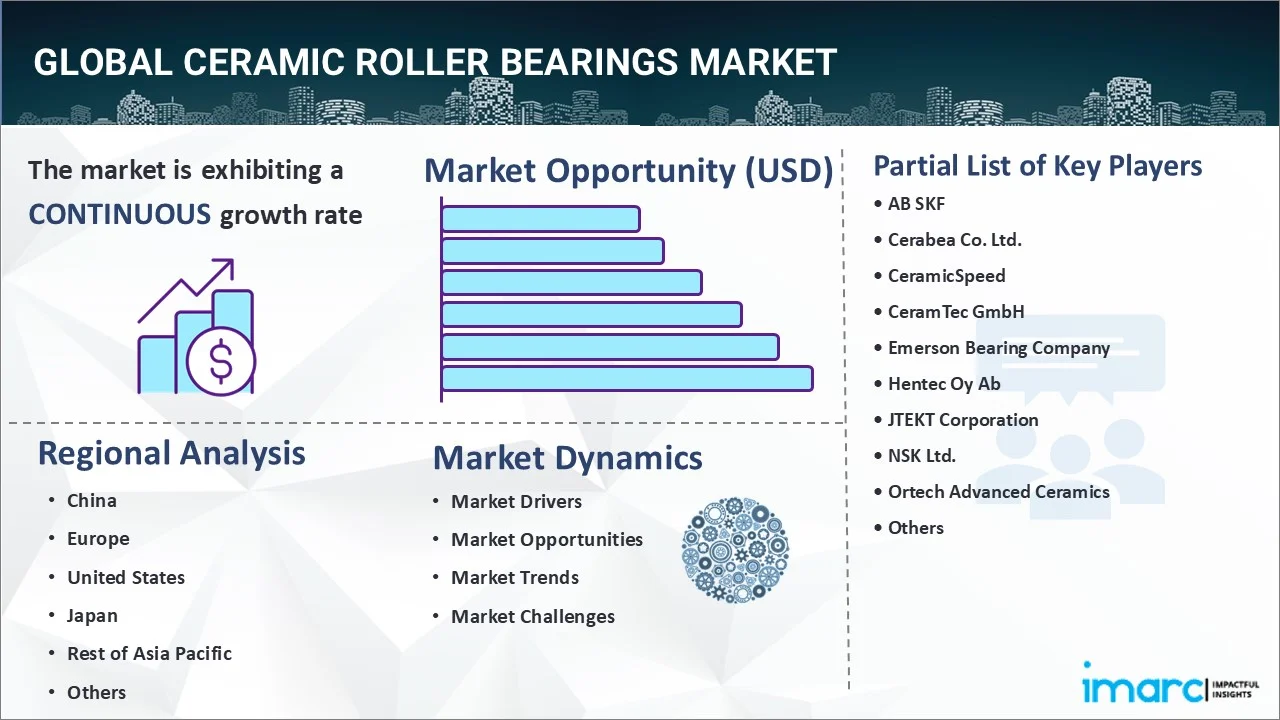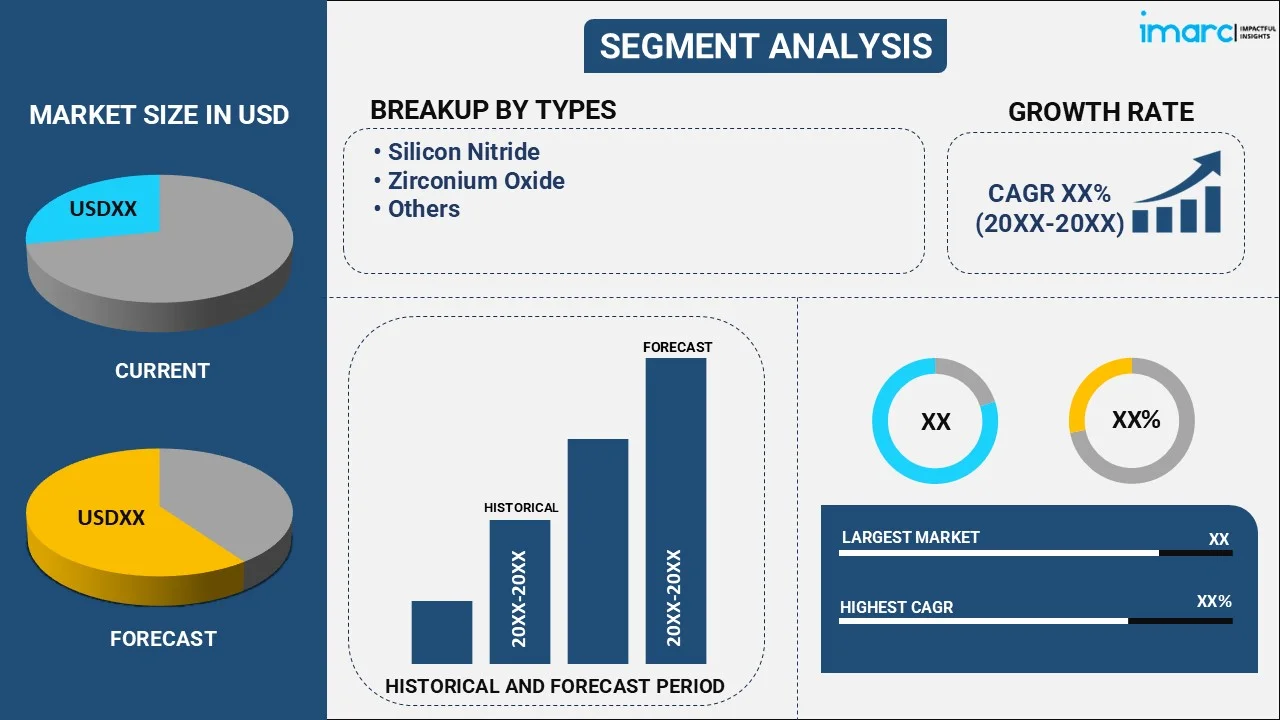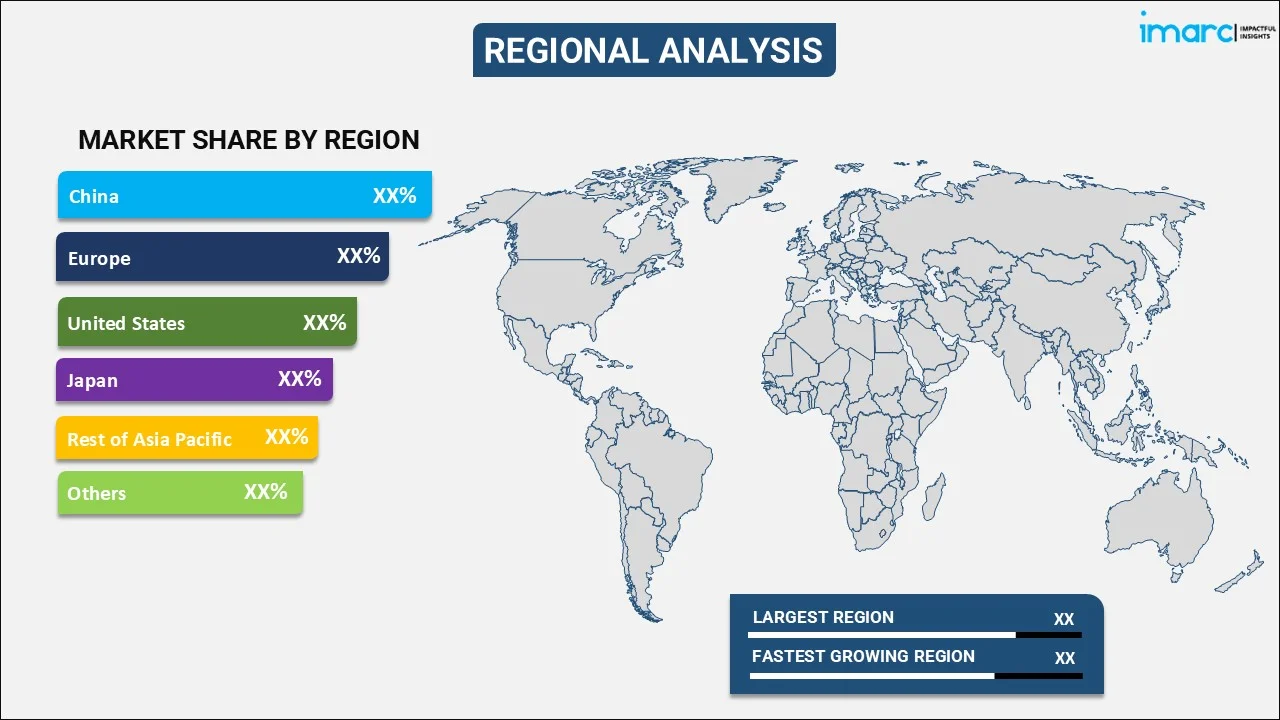
Ceramic Roller Bearings Market Report by Type (Silicon Nitride, Zirconium Oxide, and Others), Product Type (Hybrid Ceramic Roller Bearings, Full Ceramic Roller Bearings), Application (Automotive and Railways, Industrial and Mechanical Equipment, Power Generation, Aerospace, and Others), and Region 2025-2033
Market Overview:
The global ceramic roller bearings market size reached USD 440.6 Million in 2024. Looking forward, IMARC Group expects the market to reach USD 841.9 Million by 2033, exhibiting a growth rate (CAGR) of 7.5% during 2025-2033. The increasing precision machinery manufacturing, the rising use in semiconductor manufacturing, the growing demand for longer-lasting components, and the transition to cleaner and sustainable technologies are some of the factors propelling the market.
|
Report Attribute
|
Key Statistics
|
|---|---|
|
Base Year
|
2024 |
|
Forecast Years
|
2025-2033 |
|
Historical Years
|
2019-2024
|
|
Market Size in 2024
|
USD 440.6 Million |
|
Market Forecast in 2033
|
USD 841.9 Million |
| Market Growth Rate 2025-2033 | 7.5% |
Ceramic roller bearings are meticulously engineered products to support substantial loads, mitigate friction, and facilitate the precise motion of shafts and rotating components. Manufacturers utilize either full ceramic or hybrid ceramic materials like silicon nitride, zirconia, and alumina in their production. These bearings are pivotal in numerous applications, including turbines, centrifuges, compressors, automobiles, aircraft engines, dental drills, bicycles, skates, and conveyors. In contrast to conventional bearings, ceramic roller bearings exhibit superior hardness, heightened stiffness, reduced weight, diminished friction, and enhanced resistance to both corrosion and chemicals. Moreover, their reduced need for lubrication leads to decreased maintenance expenses and heightened operational efficiency. As a result of these advantages, they have garnered extensive utilization across diverse industries such as automotive, power generation, manufacturing, healthcare, chemicals, and aerospace, contributing to their essential role in modern machinery.

The global market is majorly driven by the increasing advancements in ceramic material technology. In line with this, the rising demand for high-performance components is significantly contributing to the market. Furthermore, the growing need for reduced friction in industrial applications is positively influencing the market. Apart from this, the escalating emphasis on operational efficiency and the expanding utilization in aerospace and aviation are catalyzing the market. Moreover, the increasing demand for lightweight and durable bearings and the rise in automotive manufacturing and innovation are propelling the market. Besides, the enhanced resistance to corrosion and chemicals is creating a positive outlook for the market. The power generation sector's expansion offers numerous opportunities for the market. Additionally, the increasing healthcare equipment manufacturing and the rising utilization in aggressive and harsh environments are providing a boost to the market.
Ceramic Roller Bearings Market Trends/Drivers:
Increasing emphasis on maintenance cost reduction
The increasing emphasis on maintenance cost reduction is creating a positive outlook for the market. In various industries, the need to minimize operational expenses has become paramount. Due to wear and tear, traditional metal bearings often require frequent lubrication and replacement, leading to elevated maintenance costs over time. Ceramic roller bearings, however, offer exceptional durability, reduced friction, and enhanced resistance to wear, corrosion, and chemicals. These attributes contribute to their extended lifespan and diminished need for frequent maintenance. By adopting these bearings, industries can significantly reduce the frequency of maintenance interventions, resulting in lower downtime and decreased expenses related to repairs and replacements. This cost-efficient approach enhances the overall operational efficiency of machinery and equipment and offers long-term economic benefits. As a result, the preference for these bearings to achieve maintenance cost reduction is fueling their demand across various sectors, contributing to the market's growth.
Development of specialized ceramic hybrids
The development of specialized ceramic hybrids is stimulating market growth. As industries continue to seek innovative solutions to enhance the performance of machinery and equipment, the demand for bearings that offer exceptional characteristics has increased. Specialized ceramic hybrids combine the advantages of different ceramic materials, such as silicon nitride, zirconia, and alumina, with other materials like steel or polymers. These hybrid designs aim to capitalize on the unique properties of each material, resulting in bearings that exhibit superior qualities such as high hardness, reduced friction, enhanced corrosion resistance, and improved durability. The versatility of these hybrids allows them to be tailored to specific applications where standard bearings may fall short. For instance, in high-temperature environments or aggressive chemical settings, these specialized hybrids can excel where traditional bearings would struggle. By addressing the unique challenges various industries pose, these specialized ceramic hybrids expand the scope of applications for ceramic roller bearings. This innovation-driven approach opens new market opportunities and contributes to advancements in manufacturing, aerospace, automotive, and other sectors, propelling the market.
Expansion of wind energy infrastructure
The expansion of wind energy infrastructure is offering numerous opportunities for the market. Wind turbines, essential components of renewable energy systems, operate in demanding conditions that require bearings capable of withstanding heavy loads, extreme temperatures, and continuous rotation. Ceramic roller bearings offer distinct advantages in this context, including high mechanical strength, reduced friction, and exceptional resistance to wear and corrosion. Wind energy projects are expanding as the global focus on sustainable energy intensifies. The demand for reliable and efficient bearings that can endure the rigors of wind turbine operations is consequently rising. These bearings provide a compelling solution by enhancing the reliability and longevity of wind turbines. Their ability to operate with minimal maintenance, reduced downtime, and improved operational efficiency contributes to wind energy generation's viability and cost-effectiveness. With the ongoing expansion of wind energy infrastructure globally, the adoption of these bearings is expected to grow significantly. This trend supports the renewable energy transition and stimulates innovation in bearing technology, further fueling the market.
Ceramic Roller Bearings Industry Segmentation:
IMARC Group provides an analysis of the key trends in each segment of the global ceramic roller bearings market report, along with forecasts at the global, regional, and country levels from 2025-2033. Our report has categorized the market based on type, product type and application.
Breakup by Type:

- Silicon Nitride
- Zirconium Oxide
- Others
Silicon nitride dominates the market
The report has provided a detailed breakup and analysis of the market based on the type. This includes silicon nitride, zirconium oxide, and others. According to the report, silicon nitride represented the largest segment.
Silicon nitride exhibits high hardness, excellent thermal stability, and corrosion resistance, making it well-suited for demanding environments such as aerospace, automotive, and industrial machinery. Its low coefficient of friction and capability to maintain performance in high-speed and high-temperature conditions further enhance its appeal.
Silicon nitride bearings are favored for reducing weight while maintaining durability in aerospace. The automotive industry benefits from its ability to withstand rigorous conditions, contributing to fuel efficiency and performance. Moreover, their use in medical equipment, semiconductors, and precision machinery highlights their versatility. As industries increasingly require components that can withstand extreme conditions and offer exceptional performance, the adoption of Silicon Nitride ceramic roller bearings continues to grow, thereby driving the market's overall expansion.
Breakup by Product Type:
- Hybrid Ceramic Roller Bearings
- Full Ceramic Roller Bearings
Hybrid ceramic roller bearings dominates the market
The report has provided a detailed breakup and analysis of the market based on the product type. This includes hybrid ceramic roller bearings and full ceramic roller bearings. According to the report, hybrid ceramic roller bearings represented the largest segment.
Hybrid bearings leverage the exceptional properties of ceramic materials like silicon nitride or zirconia, such as high hardness and corrosion resistance, while integrating them with materials like steel to enhance overall structural integrity and cost-effectiveness. They find applications across various industries, from automotive to industrial machinery and medical equipment. They offer reduced friction, enhanced durability, and improved performance in high-speed or high-load scenarios.
In industries where precision and reliability are paramount, these hybrid bearings offer a compelling solution that balances advanced characteristics with practical considerations. By bridging the gap between traditional and cutting-edge materials, these bearings provide a versatile option that caters to various industrial needs. Their ability to enhance operational efficiency and extend product lifespans ensures continued adoption, thus contributing significantly to the market growth.
Breakup by Application:
- Automotive and Railways
- Industrial and Mechanical Equipment
- Power Generation
- Aerospace
- Others
Automotive and railways dominates the market
The report has provided a detailed breakup and analysis of the market based on the application. This includes automotive and railways, industrial and mechanical equipment, power generation, aerospace, and others. According to the report, automotive and railways represented the largest segment.
Automotive and railways demand components that can withstand rigorous conditions while optimizing performance and efficiency. These bearings offer a solution by providing attributes like reduced friction, high hardness, and resistance to wear corrosion and extreme temperatures. In the automotive sector, these bearings contribute to improved fuel efficiency, reduced emissions, and enhanced overall vehicle performance. They find use in engines, transmissions, wheel hubs, and differentials, where their characteristics help minimize energy losses and increase durability.
In the railways' industry, ceramic roller bearings are pivotal in ensuring smooth and reliable operation of trains. Their ability to maintain performance in high-speed and heavy-load scenarios is critical for safety and efficiency. Reduced maintenance requirements and extended lifespans contribute to lower operational costs. As the automotive and railways sectors continue to emphasize advancements in performance and sustainability, adopting these bearings is set to rise, driving the market growth in these application areas.
Breakup by Region:

- China
- Europe
- United States
- Japan
- Rest of Asia Pacific
- Others
China exhibits a clear dominance, accounting for the largest market share
The market research report has also provided a comprehensive analysis of all the major regional markets, which include China, Europe, the United States, Japan, the Rest of Asia Pacific, and others. According to the report, China accounted for the largest market share.
China's robust industrial and manufacturing sectors have propelled the demand for high-performance components like ceramic roller bearings. The country's extensive production capabilities and technological advancements have led to the manufacturing of high-quality ceramic bearings catering to domestic and global markets. As a key player in various industries, including automotive, electronics, and machinery, the country's demand for reliable and efficient bearings continues to rise.
Additionally, the government's push for sustainable practices has prompted industries to seek durable and eco-friendly solutions, which aligns well with the benefits offered by ceramic roller bearings. The country's strategic investments in research and development have also led to innovations in bearing technology, enabling the creation of bearings tailored to specific industry requirements. With a growing number of applications and industries recognizing the advantages of these bearings, China's role in production and consumption is anticipated to play a crucial role in domestic and international market growth.
Competitive Landscape:
Top companies are strengthening the market through innovative approaches, cutting-edge technologies, and strategic partnerships. These companies invest significantly in research and development to create advanced ceramic materials and bearing designs that cater to diverse industry needs. By pushing the boundaries of material science, they enhance the properties of ceramic roller bearings, making them more durable, efficient, and capable of withstanding challenging operating conditions. Moreover, these industry leaders actively collaborate with automotive, aerospace, energy, and manufacturing manufacturers to customize solutions that optimize performance and reliability. Their strong global presence and distribution networks ensure these advanced bearings reach a wide range of customers worldwide. Top companies also contribute to market growth by raising awareness about the benefits of ceramic roller bearings through educational initiatives, technical seminars, and online resources. By showcasing real-world success stories and demonstrating the transformative impact of their products, they foster greater adoption across industries, driving the overall market expansion.
The report has provided a comprehensive analysis of the competitive landscape in the ceramic roller bearings market. Detailed profiles of all major companies have also been provided.
- AB SKF
- Cerabea Co. Ltd.
- CeramicSpeed
- CeramTec GmbH
- Emerson Bearing Company
- Hentec Oy Ab
- JTEKT Corporation
- NSK Ltd.
- Ortech Advanced Ceramics
- Schaeffler Technologies AG & Co. KG
- The Timken Company
Recent Developments:
- In June 2023, AB SKF entered into a joint venture with Sinoma Nitride, an industry-leading developer and producer of silicon nitride materials and ceramic balls, to deepen their cooperation within hybrid ceramic ball bearings.
- In August 2023, Schaeffler India Limited, a subsidiary of Schaeffler AG, entered into a share purchase agreement to acquire 100 percent of the shares of KRSV Innovative Auto Solutions Private Limited, referred to as "KRSV" hereinafter.
- In May 2023, The Timken Company, a global company in engineered bearings and industrial motion products, announced a new $70 million investment to expand manufacturing capabilities to support rising demand for its wind energy solutions.
Ceramic Roller Bearings Market Report Scope:
| Report Features | Details |
|---|---|
| Base Year of the Analysis | 2024 |
| Historical Period | 2019-2024 |
| Forecast Period | 2025-2033 |
| Units | Million USD |
| Scope of the Report | Exploration of Historical Trends and Market Outlook, Industry Catalysts and Challenges, Segment-Wise Historical and Predictive Market Assessment:
|
| Types Covered | Silicon Nitride, Zirconium Oxide, Others |
| Product Types Covered | Hybrid Ceramic Roller Bearings, Full Ceramic Roller Bearings |
| Applications Covered | Automotive and Railways, Industrial and Mechanical Equipment, Power Generation, Aerospace, Others |
| Countries Covered | China, Europe, United States, Japan, Rest of Asia Pacific, Others |
| Companies Covered | AB SKF, Cerabea Co. Ltd., CeramicSpeed, CeramTec GmbH, Emerson Bearing Company, Hentec Oy Ab, JTEKT Corporation, NSK Ltd., Ortech Advanced Ceramics, Schaeffler Technologies AG & Co. KG, The Timken Company etc. |
| Customization Scope | 10% Free Customization |
| Post-Sale Analyst Support | 10-12 Weeks |
| Delivery Format | PDF and Excel through Email (We can also provide the editable version of the report in PPT/Word format on special request) |
Key Benefits for Stakeholders:
- IMARC’s industry report offers a comprehensive quantitative analysis of various market segments, historical and current market trends, market forecasts, and dynamics of the ceramic roller bearings market from 2019-2033.
- The research report provides the latest information on the market drivers, challenges, and opportunities in the global ceramic roller bearings market.
- The study maps the leading, as well as the fastest-growing, regional markets. It further enables stakeholders to identify the key country-level markets as well as the fastest-growing markets.
- Porter's five forces analysis assists stakeholders in assessing the impact of new entrants, competitive rivalry, supplier power, buyer power, and the threat of substitution. It helps stakeholders to analyze the level of competition within the ceramic roller bearings industry and its attractiveness.
- Competitive landscape allows stakeholders to understand their competitive environment and provides an insight into the current positions of key players in the market.
Key Questions Answered in This Report
The global ceramic roller bearings market was valued at USD 440.6 Million in 2024.
We expect the global ceramic roller bearings market to exhibit a CAGR of 7.5% during 2025-2033.
The growing demand for ceramic roller bearings across various industries, including railways, aerospace, automotive, etc., as they offer low thermal conductivity, enhanced electrical insulation, better dimensional stability, etc., is primarily driving the global ceramic roller bearings market.
The sudden outbreak of the COVID-19 pandemic had led to the implementation of stringent lockdown regulations across several nations, resulting in the temporary closure of numerous manufacturing units for ceramic roller bearings.
Based on the type, the global ceramic roller bearings market can be categorized into silicon nitride, zirconium oxide, and others. Among these, silicon nitride accounts for the majority of the global market share.
Based on the product type, the global ceramic roller bearings market has been segregated into hybrid ceramic roller bearings and full ceramic roller bearings, where hybrid ceramic roller bearings currently exhibit a clear dominance in the market.
Based on the application, the global ceramic roller bearings market can be bifurcated into automotive and railways, industrial and mechanical equipment, power generation, aerospace, and others. Currently, the automotive and railways sector holds the largest market share.
On a regional level, the market has been classified into China, Europe, United States, Japan, Rest of Asia Pacific, and others, where China currently dominates the global market.
Some of the major players in the global ceramic roller bearings market include AB SKF, Cerabea Co. Ltd., CeramicSpeed, CeramTec GmbH, Emerson Bearing Company, Hentec Oy Ab, JTEKT Corporation, NSK Ltd., Ortech Advanced Ceramics, Schaeffler Technologies AG & Co. KG, and The Timken Company.
Need more help?
- Speak to our experienced analysts for insights on the current market scenarios.
- Include additional segments and countries to customize the report as per your requirement.
- Gain an unparalleled competitive advantage in your domain by understanding how to utilize the report and positively impacting your operations and revenue.
- For further assistance, please connect with our analysts.
 Inquire Before Buying
Inquire Before Buying
 Speak to an Analyst
Speak to an Analyst
 Request Brochure
Request Brochure
 Request Customization
Request Customization




.webp)




.webp)












